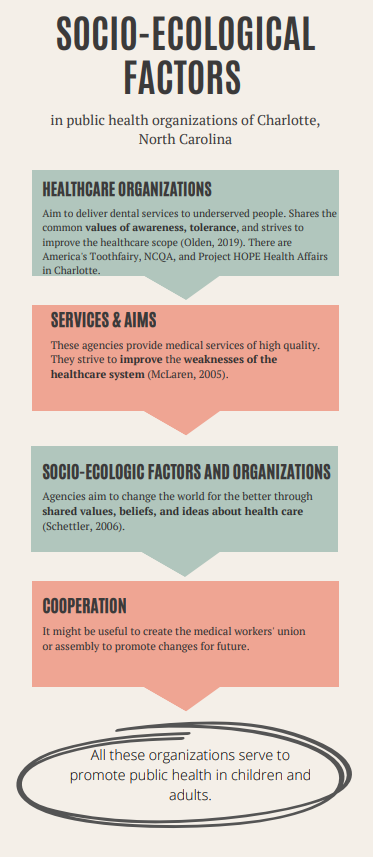Introduction
The socio-ecological model is essential for healthcare organizations to evaluate organizational objectives and adapt them. This model influences interpersonal, political, and social factors; some inequalities affect ethnic minorities, women, children, and challenged people (Brown, 2015). It is essential to examine healthcare services in Charlotte, North Carolina, using the socio-ecological model to assess services provided by these organizations, detect interconnection between socio-ecological factors and agencies, and reflect on how these organizations can cooperate to better health outcomes.
Public Health Organizations in Charlotte, North Carolina
There are multiple public health organizations in Charlotte, North Carolina. For instance, America’s Toothfairy is an agency providing dental services. This organization delivers services to underserved children by utilizing financial support and donated products and equipment. It also involves “volunteer health professionals” and caregivers to provide support (Cause IQ, 2020, para 1). The organization is seen through the socio-ecological model to provide higher values for the community, delivering services for mistreated children (McLaren, 2005). One more agency is the National Committee for Quality Assurance (NCQA), whose mission is to improve health care quality. The organization delivers professional medical services to raise the quality of health outcomes in the community.
Another organization in Charlotte, North Carolina, is Project HOPE Health Affairs, which aims to affect underserved patients positively. It also accepts donations and uses them for providing medical services to “strengthen the weaknesses” of the healthcare system (Cause IQ, 2019, para 1). It is worth mentioning that most of these organizations are funded by grant-makers and federal agencies. Voluntary support and donations are encouraged; organizations deliver their services and cooperate with partners worldwide.
It is crucial to consider that the above mentioned organizations provide patients with medical services of various complexity. For instance, it is possible to find dental, surgical, and therapeutic help there. As the point is meeting community health needs, involving underserved patients, women, children, and older adults, it is possible to say that discussed organizations appeal to the needs of these categories. Agencies strive to satisfy the needs of the community, including underserved people and involve volunteers to provide many services for free.
Aims and Socio-Ecological Relations of Public Health Organizations
It is also essential to state why these organizations provide healthcare services. Using the socio-ecological model for change is possible, which influences social, ethical, and ethical considerations in healthcare (Schettler, 2006). These agencies strive to improve the health care area by positively impacting patients’ health. Their missions assume changing for the better through implications for public health. Moreover, there are certain relationships between these agencies and the socio-ecological factors of the community. These are attitudes, beliefs, hopes for a better future, and motivation to change for the better (Olden, 2019). Furthermore, it includes tolerance and awareness for mistreated people, sociocultural and gender norms, and shared values.
Cooperation
The above mentioned organizations might cooperate in a perfectly productive way, creating beneficial cooperation for better health outcomes in the community. For instance, it is possible to attract volunteers from one of the organizations to provide services for children and adults. America’s Toothfairy provides a great example of attracting student volunteers and professionals to contribute to improving public health (Cause IQ, 2020, para 1). Moreover, it is feasible to create a local union of medical professionals and care workers who will exchange resources and knowledge to reach a common healthcare aim. This cooperation might be helpful to the most vulnerable layers of the society, who were rejected to be serviced. Moreover, jointly with federal agencies and Ministries of health, these organizations might generate a healthcare assembly.
Conclusion
Overall, the agencies of Charlotte, North Carolina, were analyzed through the framework of the socio-ecological model. It was seen that all listed organizations strive to help those who were mistreated. Furthermore, these agencies have a common aim to help patients and create a better background in public health. Interaction might be a valuable measure to promote health in Charlotte, creating a better future for people.

References
Brown, V. (2015). Using the social-ecological model to inform community needs assessments. Journal of Family & Consumer Sciences, 107(1), 45-51. Web.
Cause IQ. (2019). Project HOPE Health Affairs. Web.
Cause IQ. (2020). America’s Toothfairy | Charlotte, NC. Web.
McLaren, L. (2005). Ecological perspectives in health research. Journal of Epidemiology & Community Health, 59(1), 6–14. Web.
Olden, P. (2019). Management of healthcare organizations: An introduction. (3rd ed.). Health Administration Press.
Schettler, T. (2006). An ecological view of health. EXPLORE, 2(4), 357–360. Web.